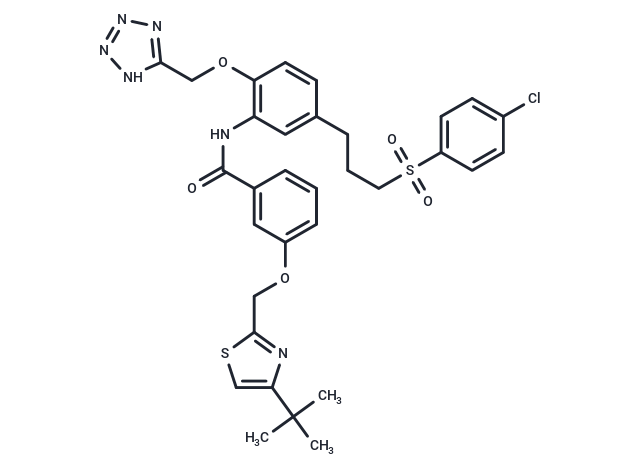Shopping Cart
- Remove All
 Your shopping cart is currently empty
Your shopping cart is currently empty

YM158 free base is a potent and selective antagonist of the TXA2 and LTD4 receptors (pA2 values of approximately 8.81 and 8.87).

| Pack Size | Price | Availability | Quantity |
|---|---|---|---|
| 25 mg | $3,020 | 3-6 months | |
| 50 mg | $3,980 | 3-6 months | |
| 100 mg | $5,500 | 3-6 months |
| Description | YM158 free base is a potent and selective antagonist of the TXA2 and LTD4 receptors (pA2 values of approximately 8.81 and 8.87). |
| Targets&IC50 | LTD4:8.87(pA2), TXA2 receptor:8.81 (pA2) |
| In vitro | YM158 exhibits competitive dual antagonism of LTD4 and TXA2 receptor-mediated contraction of isolated guinea pig tracheae (pA2s: about 8.87 and 8.81). Its antagonistic activity for the LTD4 receptor is approximately 6.5 times less potent than that of Montelukast, and that for the TXA2 receptor is 2.5 times more potent than that of Seratrodast. YM158 also inhibits PGD2- and PGF2α -induced tracheal contractions. YM158 antagonizes the stable TXA2 analog U46619-induced aggregation of both guinea pig and human platelets and inhibits the LTD4-induced contraction of guinea pig ileum. YM158 produces a concentration-dependent inhibition of guinea pig ileum contraction induced by 1 nM LTD4 (IC50: 0.58 nM) [1]. |
| In vivo | Because the inhibitory effects of YM158 on an increase in the airway resistance induced by LTD4 or U46619 are shown to be dose-dependent when p.o. administered 1 h before LTD4 or U46619 injection, with ED50 values of 8.6 and 14 mg/kg, respectively, the antagonistic activities of p.o. YM158 for LTD4 and TXA2 receptors are exhibited at the same dose range. Oral YM158 shows significant effects, approximately the same as the combination of Pranlukast and Daltroban on antigen-induced response under various conditions; namely, where LTD4 is predominant, TXA2 is predominant. In groups not treated with Indomethacin, administration of Daltroban (10 mg/kg), a combination of Pranlukast (30 mg/kg) and Daltroban (10 mg/kg), or YM158 (30 mg/kg) significantly prolongs the onset time for asthmatic response and significantly suppresses symptoms [2]. |
| Alias | YM-57158 |
| Molecular Weight | 681.22 |
| Formula | C32H33ClN6O5S2 |
| Cas No. | 179102-65-9 |
| Relative Density. | 1.383 g/cm3 (Predicted) |
| Storage | Powder: -20°C for 3 years | In solvent: -80°C for 1 year | Shipping with blue ice. |

Copyright © 2015-2024 TargetMol Chemicals Inc. All Rights Reserved.